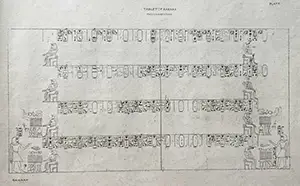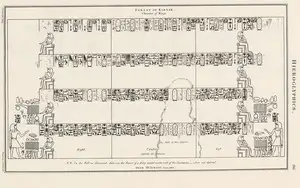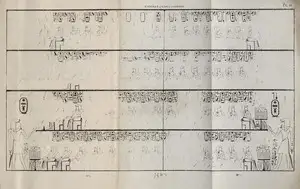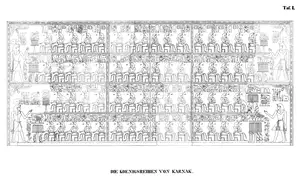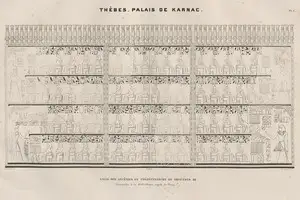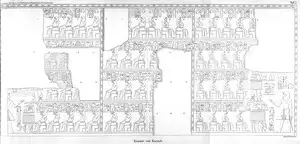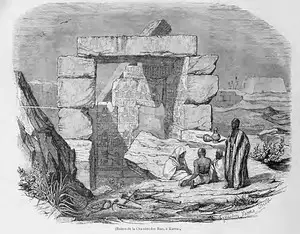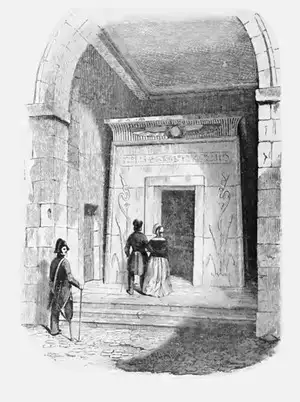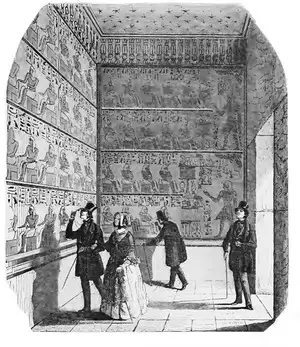Also known as the Karnak king list, it include several kings of the First and Second Intermediate Periods, omitted by the king lists of Abydos and Saqqara. Originally located in the southwest corner of the Akh-Menu Hall of the Temple of Amun-Re at Karnak.
Created during the reign of Thutmose III, it listed sixty-one kings, only the names of thirty-nine kings are still legible, and one is not written in a cartouche. Interestingly, the names include a large number of Second Intermediate Period kings not found in the other monumental king lists.
The king list was first described by James Burton in 1825, while exploring and excavating the ruins around Thebes in the early 1820s. Most likely the walls were uncovered while he was excavating the ruins, as the Napoleonic expedition did not mention or copy the scene.
In 1843, as the Lepsius expedition was traveling up the Nile, looking to purchase or scavenge interesting Egyptian artefacts. To rescue the king list from certain German acquisition, French archaeologist Émile Prisse d’Avennes had the king list dismantled at night in order to secure it for France. It was hard work that took 18 nights, but at last it was boxed and sent to Paris in 27 boxes, where it arrived in the spring of 1844. The transport caused some lesser damage to a few of the stone blocks, but the painted bas-reliefs were in a good state when inspected upon arrival. Incredibly, the boxes were then left where they stood, in the courtyard outside the Bibliothèque Royale, where they remained throughout the fall and winter.
Having given a brief overview of the origin and nature of this small monument, it remains for us to talk about the restoration that was carried out on it at the Royal Library. Despite the precautions taken by the donor, the boxes had been slightly damaged by the transport; when they were opened, three stones were broken, one of them to the point of being almost reduced to powder. Apart from this accident, no other deterioration had been suffered. Although painted simply in tempera, which is very susceptible to humidity, the paints used to decorate the bas-reliefs were in good condition when they arrived in Paris.
But leaving them exposed to rain and snow for several months was clumsy, careless or perhaps malicious. In fact, last winter, in the courtyard of the Royal Library, along the north-facing wall, everyone could see boxes piled on top of each other and barely closed. These boxes contained the stones of the Chamber of the Kings. The paint has almost entirely disappeared; it was nearly 35 centuries old.l'Illustration, June 20, 1846. (Parisian weekly newspaper)
It was finally presented to the public on 20 June 1846. Legally transferred to the Louvre in 1907, it was only moved there in the spring of 1919 and exhibited from the spring of 1922. The king list can be seen in Room 325 at The Louvre in Paris (Chapelle des ancêtres, Cat. no. E 13481 bis).
The purpose of the list was to celebrate ancestors of Thutmose III and was not meant to be a chronological list. The seemingly arbitrary positions the pharaohs are placed in does not reflect the order of succession, and is written in the tradition of Upper Egypt, concentrating on kings of the South.
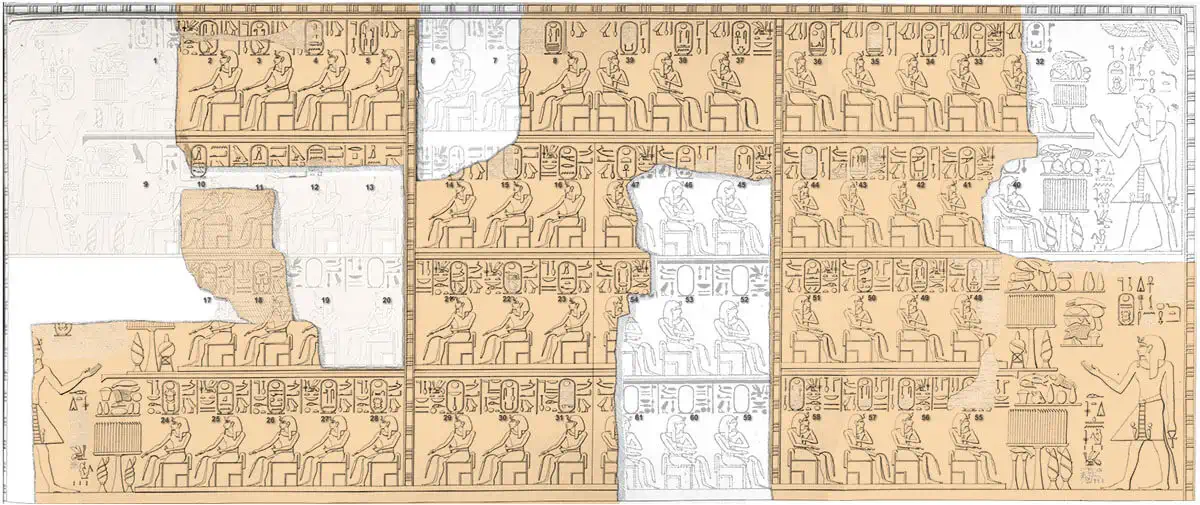
Content of the Karnak king list
Due to the poor state of the list, many of the names has been lost since its discovery. The early travellers who copied the inscriptions did so with varying accuracy.
Cartouches 38 and 57 (33, 59) record
The numbering system used in publications hail from the editio princeps of Auswahl, numbering the kings from the center to the edges, top to bottom. However, as the kings are facing the left and right edges, the correct way to read the scenes should be from the edges toward the center, which Lepsius corrected in 1853. However the numbering from Auswahl prevail, and is included in a parenthesis.
—
—
—
The powerful one of Ra, who has made the Two Lands firm
—
—
—
—
The one whom the ka of Ra has sustained
Traces of an unreadable name
The powerful one of Ra, who has made the Two Lands perfect
The powerful one of Ra is the protection of the Two Lands
He who causes the heart of Ra to live
—
—
The powerful one of Ra, who has strengthened the Two Lands
Only traces of Ra-sign remain
The one whom Ra’s heart has made perfect
The [powerful] one of Ra is enduring of appearances
—
—
The powerful one of Ra is flourishing of appearances
Only traces of Ra-sign remain
Whom the ... of Ra has made perfect
The one who ... Ra flourish
The powerful one of Ra ...
—
—
—
Gallery
Bibliography
- Map with original location of the king list
- Burton, James., 1825. Excerpta Hieroglyphica. Cairo: plate 1.
- Young, Thomas., 1828. Hieroglyphics. London: Plate 96 (copy from Burton)
- Wilkinson, J. G., 1830. Extracts from several Hieroglyphical Subjects found at Thebes, and other parts of Egypt. Malta: Pl. IV
- Lepsius, Karl Richard., 1842. Auswahl der wichtigsten urkunden des Aegyptische Alterthums. Leipzig: pl. I
- d’Avennes, Prisse., 1845. Notice sur la salle des ancêtres de Thouthmès III au Temple de Karnak. Revue archéologique II: pl. 23, pp. 5-15
- l’Illustration, Journal Universel., 1846. Vol. VII. Paris: 244-245
(English tr.)
- de Rouge, Emmanuel., June 1846. Examen de l'ouvrage de M. Le Chevalier de Bunsen. Annales de philosophie chrétienne, 78: 432-458. Plate 46
- d’Avennes, Prisse., 1847. Monuments Égyptiens, bas-reliefs, peintures, inscriptions, etc.. Paris: Plate I
- Lepsius, Karl Richard., 1853. Über die zwölfte Aegyptische Königsdynastie, APAW, 1852. Berlin: 425-455, pl. 1
- Sethe, Kurt., 1906. Urkunden der 18. dynastie Abteilung IV, Band II, Heft 5-8. Leipzig: 607-610.
- Porter, Bertha, & Moss, Rosalind., 1972. The Topographical Bibliography of Ancient Egyptian Hieroglyphic Texts, Statues, Reliefs and Paintings, II2. Oxford: 112 [342].
- Grimal, Nicolas., 2010. Les ancêtres de Karnak. CRAIBL 154.1, pp. 343-370
(original)
(English tr.)
- SITH (in French) Detailed description (by Egyptologists) of SF-5 with hieroglyphs, bibliography etc.
- The museum webpage at The Louvre.
